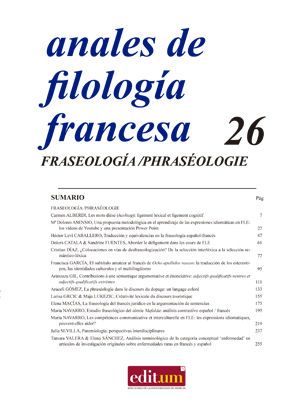This article is based on the anticipation of a triple underlying principle, the union between phraseology, expressivity, culture and interculturality, and the necessity of an impact on the teaching of foreign languages. Therefore, we have examined the exp
Abstract
This article is based on the anticipation of a triple underlying principle, the union between phraseology, expressivity, culture and interculturality, and the necessity of an impact on the teaching of foreign languages. Therefore, we have examined the experts opinions on the importance of teaching/learning phraseology, to determine when and why its learning is necessary, as well as on cultural diversity as an enriching element, both socially and interculturally. Finally, we present a didactic proposal that aims to contribute to the process of teaching/learning phraseology in French foreign language classroom by reaching out to the phraseology of the mother tongue, for raising phraseology consciousness, and introducing some French idioms. All this, taking into account the cultural diversity that may exist in the classroom and its equivalents idioms, in order to develop both, the communicative language competence and the intercultural competence.
Downloads
References
Castillo Carballo, Ma Auxiliadora. 1997-1998. “El concepto de unidad fraseológica”, inRevista de Lexicografía, Volumen IV, 67-79.
Castillo Carballo, Ma Auxiliadora. 2002. “Conocimiento cultural en la adquisición de laL 2: la fraseología” in El Español, Lengua del Mestizaje y la Interculturalidad. Actasdel XIII Congreso Internacional de la ASELE, Murcia.
Conseil de l ́europe. 2002. Cadre Européen Commun de Référence pour les Langues. Paris, Didier.
Cuq, Jean-Pierre. 2003. Dictionnaire de didactique du français. Langue étrangère et seconde. Paris, CLE International.
Cuq, Jean-Pierre et Gruca, Isabelle. 2003. Cours de didactique du français langue étrangère et seconde. Grenoble, Presses Universitaires de Grenoble.
Carlo (de), Maddalena. 1998. L’interculturel. Paris, CLE International.
Gómez Molina, José Ramón. 2004. “Las unidades léxicas en español” in Carabela, no 56,27-50.
González Rey, Ma Isabel. 2010. “La phraséodidactique en action: les expressions figéescomme objet d’enseignement” in La culture de l’autre: l’enseignement des languesà l’Université: Deuxième Rencontre Hispano-français de Chercheurs (SHF/APFUE),École Normale Supérieure Lettres et Sciences Humaines (26 au 29 novembre 2008).
Iñesta Mena, E.M. 2010. “Didáctica das expresións idiomáticas dende un enfoque plural:imaxes e emocións na aula de lingua estranxeira” in Cadernos de Fraseoloxía Galega 12, 141-153.
Solano Rodríguez, Ma Ángeles. 2007. “El papel de la conciencia fraseológica en la enseñanza y aprendizaje de una lengua extranjera” in Les expressions figées en didactiquedes langues étrangères, coord. Isabel González Rey, Louvain-La-Neuve (Bélgica),E.M.E (Éditions Modulaires Européennes) & InterCommunications S.P.R.L., 201221.
Solano Rodríguez, Ma Ángeles. 2012. “Las unidades fraseológicas del francés y del español: tipología y clasificación” in Paremia no 21. Madrid, CERSA, 117-128.
Valcárcel Ma Soledad & Mercedes Verdú. 1995. Observación y evaluación de la enseñanza comunicativa de lenguas modernas. Madrid, CIDE. Así hablamos hoy <https://www.youtube.com/watch?v=eP0vclyeuHw> [17/09/2018].
Canva< https://www.canva.com/es_es/crear/historietas> [17/09/2018].
Centre national de ressources textuelles et lexicales <http://cnrtl.fr> [17/03/2018].
Francebleu. Le Dico des Ados <https://www.francebleu.fr/loisirs/evenements/le-dico-desados> [12/09/2018].
Le Curionaute <https://www.lecurionaute.fr/langage-jeunes-ados-2017-lexique-mots-termes-dictionnaire> [12/09/2018].
Le trésor de la langue française informatisé. Dictionnaire de l’Académie française<http://atilf.atilf.fr> [26/03/2018].
Pixton <https://www.pixton.com/es/> [17/09/2018].
TV5 Monde <http://enseigner.tv5monde.com/fle/le-langage-des-jeunes> [12/09/2018]
Las obras que se publican en esta revista están sujetas a los siguientes términos:
1. El Servicio de Publicaciones de la Universidad de Murcia (la editorial) conserva los derechos patrimoniales (copyright) de las obras publicadas, y favorece y permite la reutilización de las mismas bajo la licencia de uso indicada en el punto 2.
2. Las obras se publican en la edición electrónica de la revista bajo una licencia Creative Commons Reconocimiento-NoComercial-SinObraDerivada 3.0 España (texto legal). Se pueden copiar, usar, difundir, transmitir y exponer públicamente, siempre que: i) se cite la autoría y la fuente original de su publicación (revista, editorial y URL de la obra); ii) no se usen para fines comerciales; iii) se mencione la existencia y especificaciones de esta licencia de uso.
3. Condiciones de auto-archivo. Se permite y se anima a los autores a difundir electrónicamente las versiones pre-print (versión antes de ser evaluada) y/o post-print (versión evaluada y aceptada para su publicación) de sus obras antes de su publicación, ya que favorece su circulación y difusión más temprana y con ello un posible aumento en su citación y alcance entre la comunidad académica. Color RoMEO: verde.





